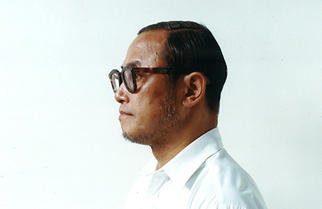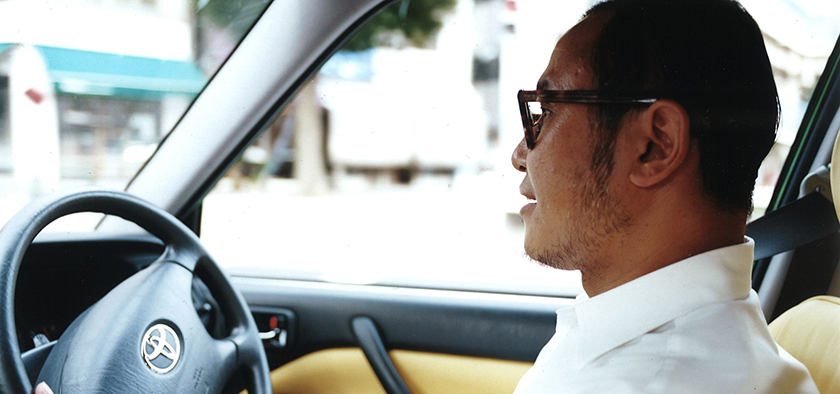
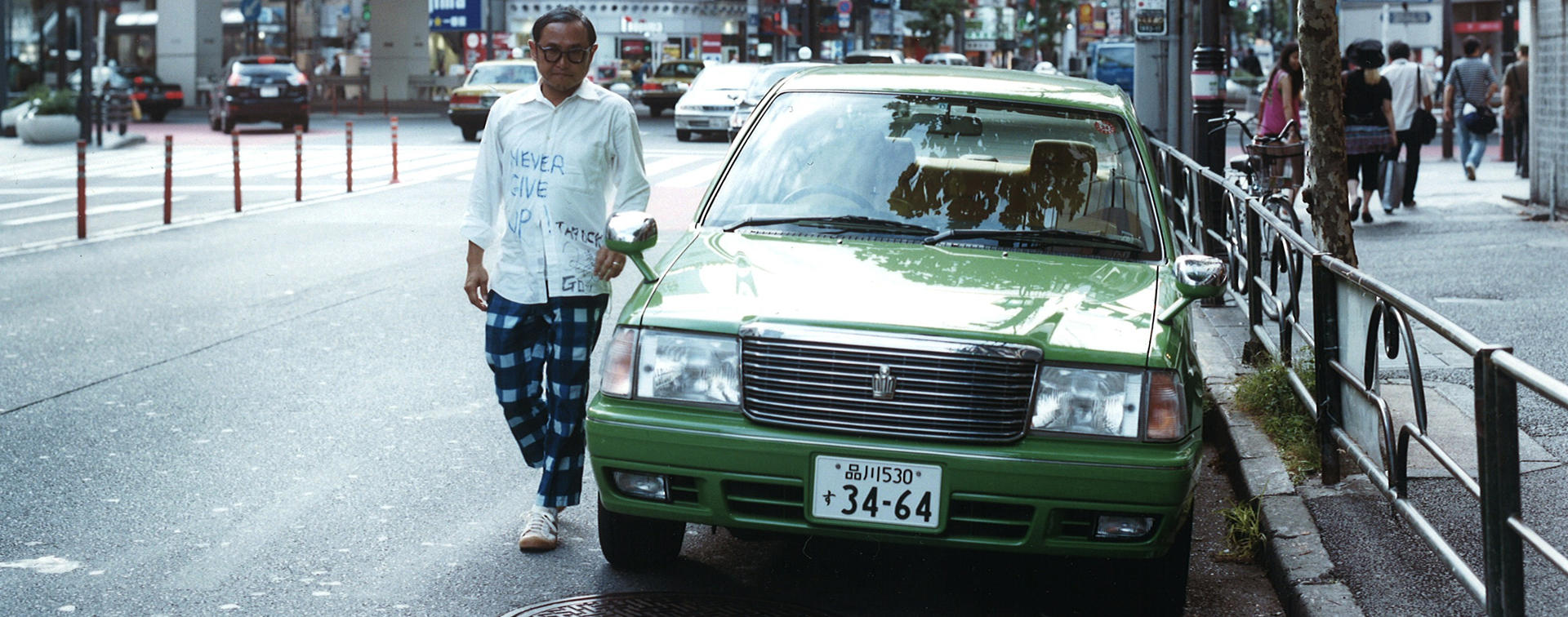
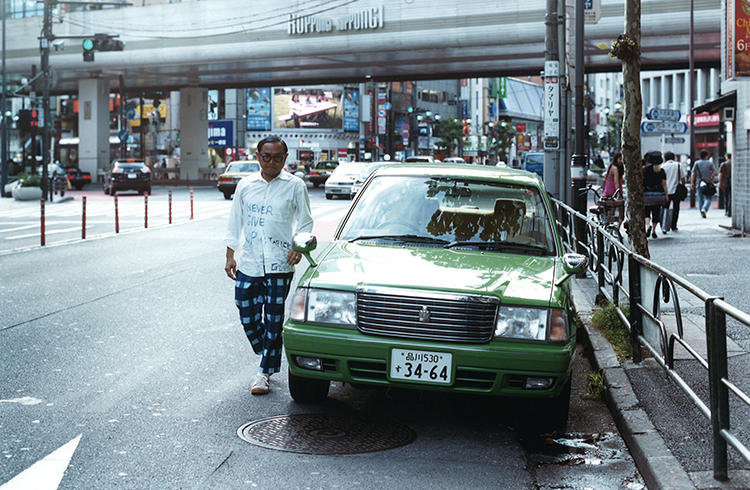
How would you turn Roppongi into an area of Design & Art?
Utilize the highway and build the “Roppongi Srab”- a piece of modern Japanese architecture
- JP / EN
Masamichi Toyama, head of Smiles Co. - the company which operates the "Soup Stock Tokyo" soup stores - is also an artist who holds exhibitions both in Japan and abroad. He has a positive attitude that is the mark of company owners. Reflecting his deep knowledge of art and architecture, Toyama came up with bold and specific ideas for the future of Roppongi. He talked flowingly of his many ideas. On the day of the interview, Toyama was wearing a one-of-a kind shirt made by artist Ichiro Endo whose motto is "GO FOR FUTURE." Toyama arrived in a bright green car which he explained had been specially customized, having been chosen from a color palette for toy mini cars. Toyama is certainly a company owner with a lot of energy.
Transforming the highway over Roppongi into a strong point
Roppongi has this rather mixed up, messy image, but I think that impression comes partly from that highway above the intersection. It would be good if we could move that road underground, but it's not going to happen so easily. So we should reverse our way of thinking, and do something to make that highway a symbol of Roppongi. A long time ago, I saw this advert in the train for a women's magazine that said something like "If you have a wide forehead, don't try to hide it. Show it to the world and your life will change." I thought to myself, what a nice feature story (laughs). It's true that a weak point can become a strong point.
Specifically speaking, we should replace all the noise-proof walls with reinforced glass, and remove the covers that are currently in place for hiding miscellaneous items from view. When you go down from the Roppongi intersection toward the Tameike area to where Ark Hills stands, you can see a part of the highway that has no noise-proof walls or covers; it's very thin and beautiful. When I looked at it, I remembered the toy called "Supercharger". The Supercharger is a race car track for the "Hot Wheels" mini cars which U.S. toymaker Mattel used to make. It was popular from the late 60s to the 70s, and my earliest memories of playing are playing with that track. The curves of the highway at the Tanimachi junctionparticularly remind me of the Supercharger.
Boulevard in the sky
We should get rid of all the unnecessary things as much as possible so that the ground or the thin slab of the highway can be seen sparkling. It would be great if we could gain cooperation from Mattel and have it painted the same orange as the Supercharger. If it's not possible to paint it all, then we could just have the walls on the sides painted. We would then have this smooth, thin orange strip stretching from Shibuya to Tameike.
And we should plant trees on the highway. That would be pleasant for the people driving; it would be nice to look up and see trees up in the sky. Whether trees can grow from thin slabs I do not know...but we should make an effort to make it a reality. Then we would have this rather unusual landscape of trees growing on the second floor of Tokyo.
"Roppongi Slab"
Allow me to tell you more of my fantasies. The highway from Shibuya to Tameike will be the "vertical axis" and the highway along the Gaien-Higashi-dori Street that stretches from the Roppongi intersection to the Tokyo Tower and to Nogizaka will be the "horizontal axis", and the floor of the highway will be made to jut out.
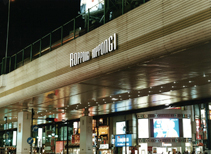
The highway above the Roppongi intersection
In March 2009, lights were installed on the bottom of the highway in Roppongi. Dubbed "Roppongi Light Stream", the lights are a new symbol for Roppongi, an area of Design and Art. The logo was designed by Kaoru Kasai, the guest for the second interview on our web magazine "Roppongi Mirai Kaigi (Roppongi Future Talks)". The lights were designed by lighting designer Motoko Ishii.
The structure will be like a cantilever, with a beam slab structure on one side only, jutting out about 20 meters. So you have this cross-shaped construction over the intersection. And this place is like a glass-walled greenhouse and can be used to hold events. Because the floor juts out, it will be called "Roppongi Slab."
At night, the Roppongi Slab becomes a venue for performances by acoustic bands or contemporary dancers, and only people with tickets can enter. It's a special place in the city, and is a perfect place to hold parties for high end brands and runway fashion shows - events that are particularly special. Observing such fun events from a little distance from the nearby buildings will also be nice.

An example of chic modern Japanese architecture
Let me think of the architect for "Roppongi Slab". Since this will be a chic example of modern Japanese architecture, I think Kazuyo Sejima or Junya Ishigami would be the ideal architects. When it has been built, people from all over the world who are interested in architecture and design will come on a pilgrimage to look at it and say, "So, this is the Roppongi Slab." There will be a staircase from the ground reaching up to the building. The staircase will be so slender that people will be amazed that it is supporting the floor. And there will be glass floors connecting the vertical and horizontal axes. Um, I think this should be designed by Ishigami-san.
Another idea I have is to make a small round-floored bar perched on the highway right above the Roppongi intersection. People in the bar will see the Tokyo Tower in front of them, and when they look behind, they will see cars speeding past. The Tokyo Tower used to be the symbol of the metropolis. Since this is Roppongi, I would love to let young people experience something similar to the Tokyo Tower during nighttime - a place that looms high in the darkness.
The same sort of bar will be built above the intersection at Iikura Katamachi. It would be like the Kawadoko (dining decks above rivers) in Kyoto. This will be the Roppongi version of Kawadoko on the highway. We could ask Ishigami-san to design the cantilever, and Sejima-san to design the bar. It would be lovely to have a bar with the thin membrane look which is a characteristic of Sejima-san's works.
Attracting proper public attention
This "Roppongi Slab" will be an attempt to change a weak point into a strong point, and to take advantage of the strength of Japanese contemporary architecture which is attracting worldwide attention. We should not make something that is just flashy and looks unnatural. It's important that we make something which is truly worth looking at and that we direct the public attention to it.
The world has its eyes on Japanese architecture because in Japan, there is the"scrap and build" custom (demolishing old architecture and building new ones) for housing, and a lot of things are permitted. This means that a lot of new challenges can be made. In Europe and other places, there are numerous regulations for architecture, and it's not easy to go ahead with projects for new buildings. I hear that young European architects work mostly in interior design. So to have an unprecedented type of building appear right in the middle of the city is something that is possible because this is Japan; it is a feat that cannot always be done elsewhere. We should take proper advantage of this and do things that will make people say, "This kind of building would not be possible on the Champs-Élysées in Paris, but wow, it's possible in Tokyo."
Bold projects in the center
There are things that are fun precisely because the location is Roppongi. We should implement bold projects right in the center. Right in the middle of Minato City, we could have floors that jut out. There are architects who understand the aggressive element in the environment of Roppongi, and are capable of incorporating that element in creations of high standards. And from a cultural aspect, people are ready to appreciate such architecture. The wonderful thing is that young Japanese, regardless of whether or not they are studying architecture, can easily tell you the names of three or four architects.
If we have this sparkling structure in the sky, people will start feeling that they should also remove the dirty things on the ground they walk on. Right now, tenants on the first floor of a building pay the highest rents; the rents usually become cheaper on the higher floors. But if we have this attractive structure in the sky, the third floor facing the highway might become the most expensive floor. New values such as these might be born.
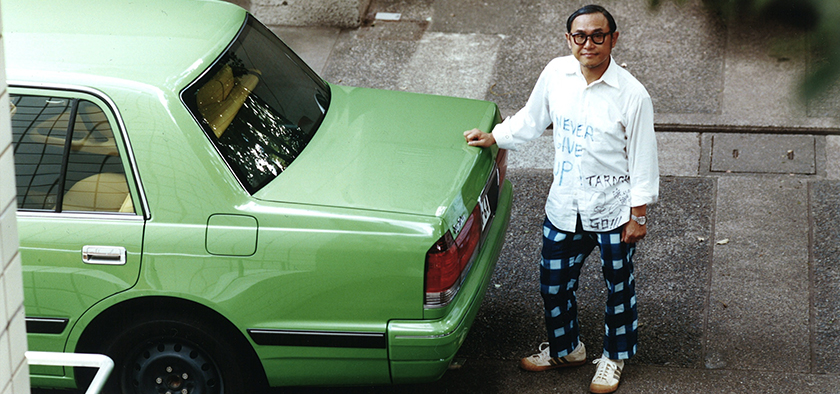
In my job, what I'm currently interested in are auberges (inns). I have a wish to connect the city and the countryside and operate places that serve as both inns and restaurants, making use of the good qualities of the countryside. The positive aspects of the countryside are the clean air, the greenery, the tasty food, the cheap land and so on. On the other hand, there are also many negative aspects - there are many tough aspects from a business perspective, such as the difficulty of attracting customers. But I think that there is a certain potential lying behind these negative and difficult factors.
When I started the soup restaurant "Soup Stock Tokyo", I began by thinking about the elements of fast food shops that were not pleasing to me. It was the same with the necktie shop "giraffe" and the recycle shop "PASS THE BATON"; I started by thinking about the improvements that could be made to the shops that already existed. So when there are negative factors, it's possible to look at the situation as an attractive starting point for something new.
Negative factors can lead to new values
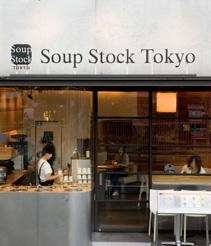
Soup Stock Tokyo
Operations started in 1999 with the concept of "enriching people's lives through food."Nearly 60 restaurants, many of which are located on the compounds of train stations or in the restaurant malls of office buildings, are located nationwide and provide nutritious meals for busy city dwellers.
A new relationship between the city and the countryside
I'm interested in auberges because I think people should be able to go back and forth to the countryside in a more casual way; while the countryside is pleasant, there are many obstacles to overcome in order to live there permanently. There are people who want to take the good elements of the city to the countryside; there are many who say they would like to live in the countryside for a year or two like in the "sankinkotai" system ( a system in the Edo period where feudal lords spent every other year living in Edo). Of course, I would like to do this based on a cooperative relationship with the local people. I feel that one of the easy-to-understand ways to go about this is to operate auberges. Many members of staff at Smiles are originally from outside Tokyo, so I think it will be good if some of them ultimately decide to return to their hometowns and become owners of auberges and so on.
The town I personally like best is Daikanayama where I have been living for nearly 20 years. There's the Daikanayama Tsutaya Bookstore beside the Hillside Terrace now, and there's a nice feeling of liveliness. Yet at the same time, the place retains its calmness. The people in the town seem to be quietly considerate and courteous toward each other. But I'm not saying that those things should be brought to Roppongi. Roppongi has a diversity that Daikanyama does not, and we should think of ways to enjoy that diversity.
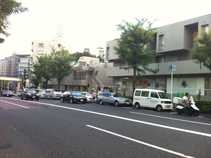
Hillside Terrace
A complex facility designed by Fumihiko Maki comprising residences, shops and offices on the old Yamate Dori street in Shibuya City's Sarugakucho. An architectural exhibition held at the Hillside Gallery is known as a gateway to success for up-and-coming architects. Many other cultural events are held here including the Hillside Plaza Concert.
Roppongi is also a cool place
I said earlier that Roppongi has a mixed and messy image, but I should add that in my view, Roppongi has always been a cool place. There used to be this cool bar in Iikura called "Gaslight." When I was a student, Roppoingi was about the only place to go to for drinking, and an older cousin used to take me to a jazz bar overlooking the Roppongi intersection. The first memories I have of eating out are also of Roppongi. I remember going to "Nicola's" and the Russian restaurant "Volga" in Iikura. There was also an establishment called "Mamiana (tanuki hole) Soba." It was in front of the Russian Embassy and used to be a place where tanuki (Japanese raccoon dogs) appeared.
I still come to Roppongi. Sometimes, I go into establishments just by myself. A few months ago, I wandered around the deep end of Roppongi and in about two places, I was forbidden entry. They told me that they don't accept first-time visitors. They barred me from entering even though there were no other customers. I was impressed by their pluck. It's a very tough business environment for everyone these days, and to say "no" to a customer shows a fine spirit. So I'm thinking of going to those places again. Perhaps if I go two or three times, they might say, "I've seen you somewhere before," and let me in. It's an aspect of Roppongi that I don't dislike. (laughs)
Editor's thoughts
I had fun getting a ride on Toyama-san's prized car. When we went past the Roppongi crossing, the car navigation system gave off a rather loud, high-toned sound. Toyama-san said he does not know what that sound is for. The highways are one of the symbolic features of Roppongi, and if we could make better use of them, I think the area would become more interesting. (edit_rhino)




